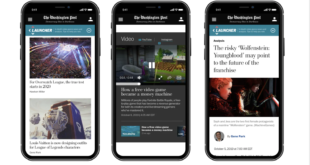ABC data would have you believe games magazines are dead in the water. James Batchelor looks at how print brands retain their power in a changing media landscape…
Once again, fresh figures from the Audit Bureau of Circulations show that specialist gaming magazines are in decline. And it’s getting worse.
Here are the cold, hard facts.
Two magazines lost more than a quarter of their readerships in the past twelve months, their circulations dropping to less that 10,000.
All but two publications saw their audience fall by more than a tenth.
Across the board, that’s a loss of 54,008 readers – more than the total readership of each magazine, savefor OXM.
That’s a tough number for any magazine publisher to put a positive spin on.
Sure enough, moments after the ABC’s latest report was released, the familiar cry of ‘print is dead’ could be heard from all corners of the industry. And while the medium’s steep decline is undeniable, publishers are fighting to keep their magazine brands alive.
This coming year is likely to be even tougher for print, so you can expect to see our portfolio change with the times and evolve to both better cope with the market conditions and serve the readership in the best way possible,” says GamesTM editor-in-chief Rick Porter.
But Eurogamer’s operations director Tom Bramwell is not quite as optimistic: Sadly I think there will be fewer games magazines than ever by the time you’re asking me this question next year.”
PRINT’S NEXT OF KIN
But does this mean Future and Imagine are on the precipice? Doomed to collapse when their magazine readerships reach an unbearable low? Of course not.
Both companies have found a multitude of additional revenue streams through different formsof media.
For one thing, they each have an entire network of websites, led by flagship online brands such as CVG and NowGamer, with standalone websites for all of their print properties. The readerships of these sites comfortably stand shoulder-to-shoulder with online-only giants such Eurogamer, GameSpot and IGN, with hundreds of thousands of monthly unique users.
Plus, the two firms have made their magazines available digitally through Apple Newsstand and – and these circulations are not counted in ABC’s standard certificate figures. Imagine claims its entire digital portfolio is selling well, while Future’s early Newsstand download stats are promising.
ABC data shows that Edge was the 15th highest selling digital consumer magazine across all categories, with an average monthly circulation of 2,183. It’s important to note that this is calculated across the whole year but Edge has only been available on Newsstand for three months – so its monthly digital circulation will actually be higher.
As digital continues to overtake physical in all walks of life, is this to be expected?
Consumers still enjoy the print format but shopping habits have changed – we all go to the shops less so there is no surprise that publications will suffer some decline,” says Future publisher director Simon Maxwell.
Some consumers want the same experience but in digital form, and our move to Apple and other mobile devices has cemented this belief.”
Future also reaches consumers through the three consoles with The OXM Report for Xbox Live, Nintendo TV on both Wii and 3DS and PlayStation Access. Where are the ABC figures for these channels?
VIDEO KILLED THEMAGAZINE STAR
On-console broadcasts highlight another key factor in print’s decline: the rise of video.
Original filmed content is more important than ever to media companies. GameSpot UK prides itself on weekly shows such as Start/Select, while IGN is working with TV producers on its YouTube channel, Start. Print firms are making similar investments, recognising that readers are becoming viewers.
It’s only really in the last few years that the potential of video is being tapped into,” says NowGamer’s editor-in-chief Nick Jones. Sites have invested in high-quality TV-standard video content and can now compete with more traditional media outlets. In fact, I’d go as far to say that people who bemoan the lack of a terrestrial games show on TV are missing what’s happening online.”
IGN editor-in-chief Alex Simmons adds: The rapid growth of internet-connected TVs has triggered a silent revolution in living rooms. Most mid-range TVs make it as easy to watch a YouTube video as they do an episode of EastEnders. It would be pointless trying to re-create the success of GamesMaster through terrestrial TV channels.”
THE NOT-SO-SMALL PRINT
Many say print is an outdated medium being replaced by its online successors: blogs, and video and on-console shows.
But don’t be fooled into believing there is no demand for gaming magazines. As games become more and more mainstream, so do the publications that cover them.
Free men’s lifestyle mag Shortlist has picked up several Games Media Awards, and has a more than healthy readership of 526,359 – more than all games magazines combined.
And the official Moshi Monsters magazine is picked up by more than 143,000 per month, making it the top children’s publication less than a year after it launched.
As Steve Payne wrote last week (Why ABC isn’t enough, MCV 675 17/02/2012), magazine publishers are essentially forced to go on the defensive around this time of year.
But much like the retail charts have become misrepresentative of the games market’s value, circulation figures are now unable to convey how many consumers rely on print brands.
PUTTING THE MEDIA IN SOCIAL MEDIA
Arguably, games magazines are as much a channel as they are a form of content. They’re a monthly care package of news, previews and reviews delivered to WH Smiths for gamers to pick up when they need an update on the industry’s latest happenings.
But there is another channel that is becoming just as, if not more efficient than monthly issues: social media.
All media firms, whether print or online based, have mastered the art of using Twitter and Facebook to push their biggest articles directly to readers within minutes of publication.
It’s true – and quite obvious – that people who follow an official feed or page are going to lap up any new info on a game they’re interested in,” says NowGamer editor-in-chief Nick Jones.
With a partnership like this, the press can create great content and publishers can target it at exactly the right audience. Everybody wins.”
Of course, the channel must be used responsibly, with just as much emphasis on interaction with readers as on broadcastto them.
Publishers that only focus on building the largest numbers of Followers ‘receiving’ messages are seriously missing a trick,” says IGN’s Alex Simmons. Spend any time with the new Facebook and Twitter analytics tools and you realise that two-way engagement metrics such as ‘Talking About’ give you the real picture of how your brand is building.”
Eurogamer’s Tom Bramwell adds that it can be particularly useful at making your content stand out from the competition: Social media also favours people who produce original content because people only share things that they think are interesting enough for them to want to associate themselves with. The nimbler and more adaptable press institutions have benefited from this greatly.”

 MCV/DEVELOP News, events, research and jobs from the games industry
MCV/DEVELOP News, events, research and jobs from the games industry



